Aden/Yemen History
In January 1839 the British attacked and occupied the port and town of Aden. The aim was to protect the trade route to India and to provide a coaling station between Bombay and Suez where coal fired ships could refuel. Gradually they moved inland and established the Aden Protectorate. Because of this anyone from Aden was classed as a British subject. People from the inland areas came to the port looking for employment but would often return to their homes after several months, often repeating this year after year. As the port of Aden expanded more unskilled labourers were needed, mainly as fireman shovelling coal into the fires of the coal fired steam ships. The coaling depot at Tawahi became known as Steamer Point. Aden is now part of Yemen.

Fireman on coal ships
Frank Bullen in “Men of the Merchant Service” gives this horrifying account of the role of a fireman:
The fireman is called with the sailor at eight bells. Hastily putting on his shirt, trousers, and boots, he descends by many iron ladders past grim walls of iron that glow with fervent heat, and give out a vibrant hum, telling of the pent-up power within. Down, down he goes, until at last he stands upon an iron floor slightly raised above the very bottom of the vessel.
In front of him towers the face of the boiler that now claims him as its slave for four hours. And there is no time to be lost. Seizing a shovel, he lifts with it the latch of one of the doors, and flings it wide open with a clang. The ship may be rolling furiously, tumbling to and fro with that peculiarly disconcerting motion that seems to a landsman the subversion of all principles of uprightness, but he must balance himself somehow. With legs spread wide apart, he stands upon that slippery iron floor, stoops, and peers within at the roaring cavern of almost white-hot coals. His trained eye can see just how they are burning; where clinkers are forming, whether perfect combustion is going on, or certain expert manipulation is necessary in order to make it do so. If all is satisfactory he shifts his position slightly sideways, so that he can swing his shovel on one side to the bunker door, at the sill of which a heap of coal is lying, fill it, and then, with a peculiar stroke, send its contents broadcast over the lambent surface of the furnace bed.
After he has been “firing” for a certain length of time he perceives the necessity for “cleaning fires.” Then the fireman flings wide the door of the furnace to be cleaned, plunges his tools into the heart of the fire, and thrusts, rakes, and slices, until he presently, half roasted, drags out on to the stokehold floor a mass of clinker. This sends out such a fierce upward heat that it must needs be damped down, the process being accompanied by clouds of suffocating steam-smoke. But there is no time to be lost. Again and again he dives into the heart of the furnace, each time purging it of some of the deadening clinker, until, at last, with smarting eyeballs, half choked, half roasted, and wholly exhausted for the time, he flings a shovelful or so of coal upon the now comparatively feeble fire, and retires to call up his reserve of strength.
The amount of strain has been officially recognized in the arrangement of firemen’s watches. Instead of getting four hours on and four hours off, as do the sailors, they have four hours on and eight hours off, so that the exhausted frame may be able in some measure to recuperate. Some ships require three thousand tons of coal for a single passage, it being consumed at the rate of between twenty and thirty tons per hour! (Ed: That is about one large lorry load of coal per hour!)
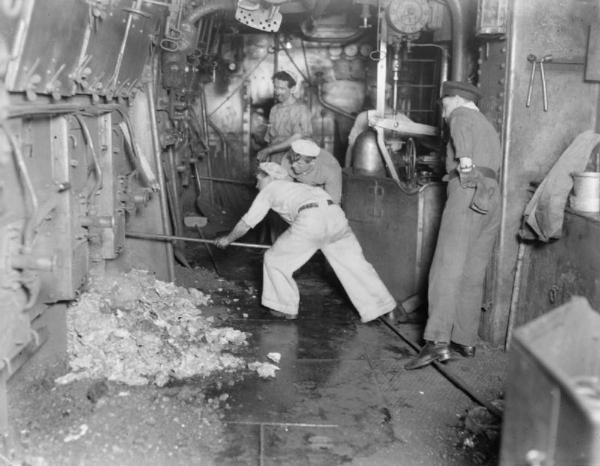
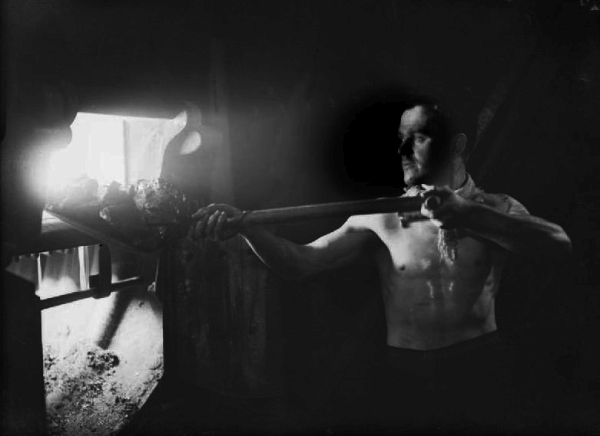
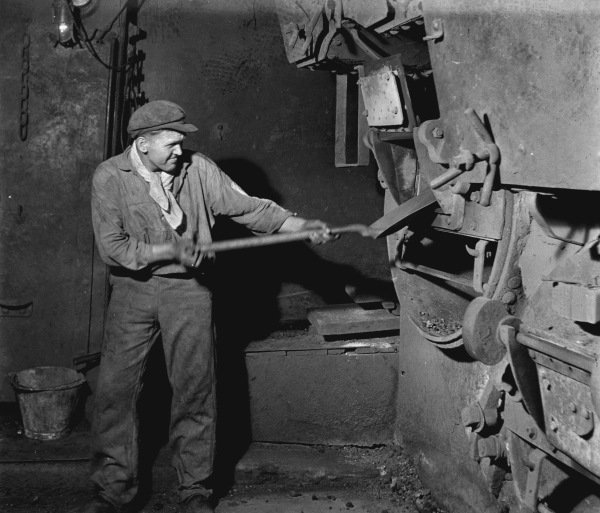
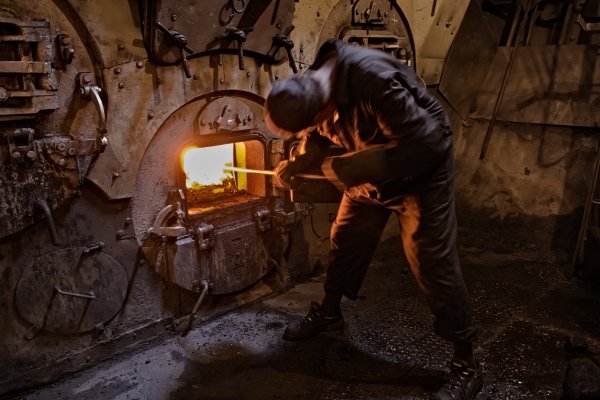
One old Arab seaman told Yusef Abdullah that:
“It was very, very tough work during the war. They were shipping sailors from America to France and it was round the clock work. He had his boiler suit on and they just slept where they fell when it was their time for break. He remembered one time taking his boots off and when he woke the rats were eating his feet!”
The first Yemenis in South Shields
Yemeni sailors had probably been discharged and boarded ships in South Shields since the late 1800s but as most were transient seamen they would be unlikely to appear very often in official records. There are no obvious Arabic names in the 1901 census or before. Searches through the Shields Gazette indicate 40 Arabic names prior to 1914. Most lived around the Holborn area.

Ali Said is one of the earliest Yemenis we have some information about he was the first Yemeni boarding house keeper. In 1917 the Shields Gazette mentions that Ali Said had been a resident for 23 years ie since 1894. In 1914 he stated he came from Aden, he had been a seaman and had saved about £70 with which in 1903 he commenced business as a coffee-house proprietor in Commercial Road. In 1906 he closed the coffee-house and opened a boarding house in Nile Street, and that was closed in 1911. In 1910 he began trading as grocer and boarding-house keeper at 77 and 79 East Holborn. (Shields Gazette 10/12/1914). He married Catherine Kail in 1906 she died in 1911 and then he married Mary Ellen Hardy in 1911. Ali Said later became a leading figure amongst the Yemeni community.
Mohamed Muckble was known as the father of the Arab community due to being one of the first generation migrants. He opened one of the first boarding houses at 20 Nelson’s Bank in 1913. He married a Scottish woman called Rosetta. Together they ran several boarding houses in East and West Holborn they operated these until Holborn was largely demolished in 1936.

Rosetta died in 1965 and Mohammed Muckble lived until 1968 when he was about 85, he is buried in Harton Cemetery.

1901 Census
No people born in Aden or with an Arabic name indicated in the 1901 census.
1911 Census
The 1911 census has 12 people born in Aden. Ali Said was one at 1 Nile Street (near the old Rose & Crown pub). He lived there with his first English wife Catherine. Five Adenese ships firemen were also living in Ali Said’s boarding house.

Five Adenese firemen were on board the Steamship Elleray berthed on the Buoys at Tyne Dock. Lastly 23 year old Mahomet Hassen a fireman was in the Harton Workhouse, he was probably destitute.

1914-18 War
During World War One a large volume of British merchant seamen enlisted in the armed forces to fight. The Government and shipping owners recruited workers from the colonies to fill these vacancies. This is the period when the big influx of Yemeni seamen arrived in South Shields. 2,479 British merchant vessels were lost in World War One and 14,287 men died many of these would have been Yemeni seaman. Most Yemeni seamen were employed as firemen in the lowest point of the ship where they would have had the least chance of survival if the ship was sunk.
Salem Abuzed was a Yemeni fireman onboard the steamship May Scott when it was captured in August 1914. He was sent to Ruhleben prison camp where because of his colour he was singled out for brutal punishment. He would have died of starvation if the Red Cross parcels had not arrived. He wrote a lovely thank you postcard saying:
“My master of noble character, the honoured Mr. Paynter, may God be gracious to him. I have received at this time your most generous gift. For your goodness may God reward you and may the nightingales of affection continue to sing in the garden of your house by His grace and mercy. He who prays, Salem Abuzed.”
Salem Abuzed came back to South Shields and opened a boarding house at 25 East Holborn and he became a prominent member of the Yemeni community.

Doctor Abdul Majid the barrister for the Islamic Society told the Shields Gazette:
“When the ranks of our mercantile marine were becoming seriously depleted through Germany’s campaign of submarine piracy. Thousands of natives came from Aden for the engine rooms and decks of British vessels … and despite the hazardous nature of their calling they “carried on” resolutely throughout the war and of those who sailed from the Tyne no fewer than 700 lost their lives through enemy action.” (Shields Gazette, March 11, 1919, page 2)
1919 Riot
During the war workers from the colonies including Aden were recruited to meet increased demands from shipping as many merchant seamen volunteered to fight. When peace came, the shipping industry contracted and all workers were affected, including merchant seamen returning to their home ports after serving in the armed forces. At the end of the First World War, the demobilisation of troops caused severe post-war competition for jobs. The 1921 census has 800 people whose occupation is given as “Seaman” of those 465 are marked as “unemployed” or “out of work” which is 58%, it was undoubtedly higher. Generally Adenese seaman were paid about one quarter of their white counterpart and this was a frequent source of friction.

On the 4th February 1919, nine Arab seamen were going to sign on a ship, Richard Lawless believes that this had probably being pre arranged with an Arab boarding house keeper. This was a common but controversial practice which the white crews objected to.
The Shields Daily News 11/02/1919 page 3 gave the following account of what the court said happened:
In opening the case, Mr Smith said the ‘circumstances were that on the afternoon in question nine Arab seamen had been engaged to attend at the Shipping Office at 2.30 in order to sign on a ship, There was a great number of people round the Shipping Office at that time. The Arabs just went to the Seamen’s Union offices and paid a sum of £18 arrears of subscriptions in order to keep their books clear. They then went to the Shipping Office, and while they were in the office, the defendant, who was the delegate of the Cooks’ and Stewards’ Union, came down, and said to the crowd, “Don’t let these Arabs sign on the ship.” He then shouted, “Come out you black —. You are not going to join the ship.”
“That language,” said Mr Smith, ‘‘used to a crowd anxious to get employment and used by a known official, was likely to incite the crowd. It was actually the dropping of the match into the keg of gun powder.”
Proceeding, Mr Smith stated that the Arabs afterwards came out, and one of them asked Fye why they could not join the ship as they had paid their union subscription. Defendant then repeated, ‘You black —, this ship is not for you.” This Arab was so provoked and incited that he struck Fye with his flat hand. Defendant then knocked this Arab down, and when the complainant went to the assistance of his fellow-countryman, Fye struck him on the hand with a stick. “You know what happened after that,” added Mr Smith, “and I am going to suggest, and suggest very forcibly, that if it had not been for the action of this union official in making use of these remarks to a crowd composed largely of alien seamen, nothing would have happened.”
Shields Daily News 04/03/1919 page 3 continues:
At this time there was only a small number of them, and they were driven back into Brewery Lane, so that the space in front of the Shipping Office and the Mill Dam was cleared. If the matter had stopped there, no one would have suggested that a riot had taken place up to that moment. What had happened was an unfortunate insult to the Arabs by Fye and an unfortunate assault upon Fye, but after the Arabs had been driven back to Brewery Lane there came back from the Arab quarters in East Holborn an organised and armed party of Arabs probably numbering about 50, and swept down the narrow street into Coronation Street.
They drove back the white sailors, who were unarmed, and forced them back into Coronation Street. From time to time during the succeeding hour the battle, for it really was a battle, took a form of organised rushes on the part of the Arabs, and in one of these rushes Mr Gibson, who had been standing quietly at the Shipping Office door, was very severely injured, having his arm broken in two places. Found as they were with sticks, cobbles-stones, some of them with revolvers and some with full lemonade bottles, which made a very formidable weapon when used at close quarters, they could imagine that the people of the neighbourhood were alarmed by the conduct of these men. Eventually a telephone message was sent to the naval vessels in the river, and a naval detachment, and a detachment, of D.L.I., together with a large number of police officers, arrived upon the scene, and gradually drove the Arabs back to East Holborn, where their own quarters were situated. (Shields Daily News 04/03/1919, page 3)
13 Arabs were brought before the magistrates in South Shields and charged with rioting: “persons to the number of ten or more unlawfully, riotously and routously did assemble and gather together to disturb the public peace…” They were then referred to the Durham Assizes where 3 were acquitted and the remainder were sentenced to imprisonment for between one and three months. The union official John Fye was found guilty of a breach of the peace and bound over for 12 months, no other white person was charged. Their defence team disputed the use of the charge of rioting, claiming unsuccessfully it was self defence.
The only people involved in the riot were white seaman and Arab seamen the dispute centred around competition for jobs. Some of the language used and the officials, police and press may have been racist but the fight was between different groups of seaman trying to find jobs in a desperate employment situation with discriminatory working practices, it was about jobs rather than race.

Sources:
British Newspaper Archives
Richard Lawless: From Ta’izz To Tyneside
Laura Tabili: Global Migrants Local Culture
Shields Daily News 05/02/1919, 06/02/1919, 11/02/1919, 12/02/1919, 03/04/1919, 05/03/1919, 06/03/1919
1921 Census
The 1921 census indicates that 526 men were from Aden and were resident in South Shields on the census date 19th June 1921. They were nearly all living in boarding houses mainly in the Holborn area. The majority gave their occupation as firemen or seamen and most were “Out of Work”. Other seamen who were not Yemenis were also out of work due a slump in employment after World War One. Many of these boarding houses for Yemenis and other seamen indicate that 100% of seamen were unemployed.

14 Yemeni firemen were on board 5 ships berthed in the river Tyne.

19 Yemeni men had married British women, 6 of those families had children. The general trend was single men arrive as firemen onboard ships of whom a small percentage accumulate enough capital to start a business usually a boarding house, café or shop, some of these marry British women and then start families. The vast majority were single ships firemen who normally would have expected to return to sea if there had not been a severe recession in the country. The national unemployment rate was 23.4%, South Shields had at least 8,000 unemployed and a scheme to put trees and a path around the Bents/Dragon was implemented to help reduce unemployment.
| Address | No | Owner | Aden birthplace |
| Chapter Row | 10 | Hassen Mohamed | 55 |
| Commercial Road | 42 | Hamed and Kate Alwin | 13 |
| East Holborn | 6 | Mahomet and Rosetta Muckble | 9 |
| East Holborn | 25 | Said and Josephine Hassen | 22 |
| East Holborn | 79 | Ali and Mary Ellen Said | 37 |
| East Holborn | 81-85 | Abdul Carder and Elizabeth Zaid | 30 |
| East Holborn | 89-95 | Abdul Carder and Elizabeth Zaid | 32 |
| Long Row | 24 | Hamid Abdulla | 19 |
| Nelson’s Bank | 20 | Mahomet and Rosetta Muckble | 40 |
| Point Ferry Approach | Said and Ethel Mabrouk | 53 | |
| Thrift Street | 4 | Nassar Abdulla | 28 |
| Thrift Street | 63 | Nassar Abdulla | 56 |
| Ships berthed in Tyne (5) | 14 | ||
| Other boarding/lodging Houses | 132 | ||
| Totals | 526 |
1930 Riot
During the 1920s and 1930s the National Union of Seamen (NUS) tried to stop the use of non British seaman in the Merchant Navy. The Seamen’s Minority Movement (SMM) a left wing organisation accused the NUS of colluding with the ship owners which led to pay cuts for all seamen. A rota system was introduced in July 1930. The SMM held peaceful protests outside the NUS offices in the Mill Dam. On the 2nd of August 1930 a violent clash occurred between the Arabs and some white seamen on the SMM side against the white NUS seamen. Ali Said was given 16 months imprisonment and later deported as were many other Arab seamen, the leaders of the SMM were given 8 months imprisonment. Half of the Arab seamen came from Said Mabrouk’s boarding house at 2 Laygate Street and Salem Abuzed’s at 25 East Holborn. The violence initially occurred between two rival seamen’s trade unions with different ideologies and then became a conflict with the police so could not really be referred to as a “Race Riot”.

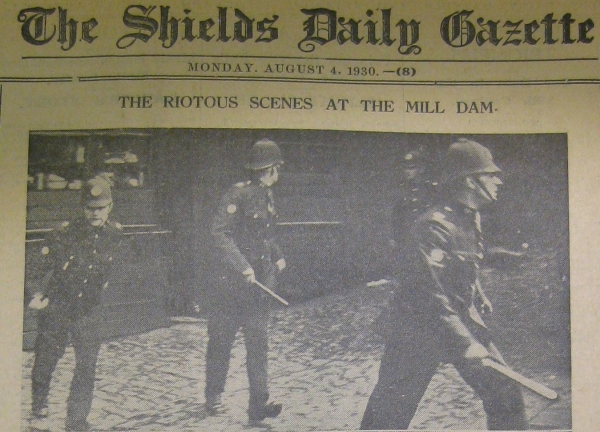
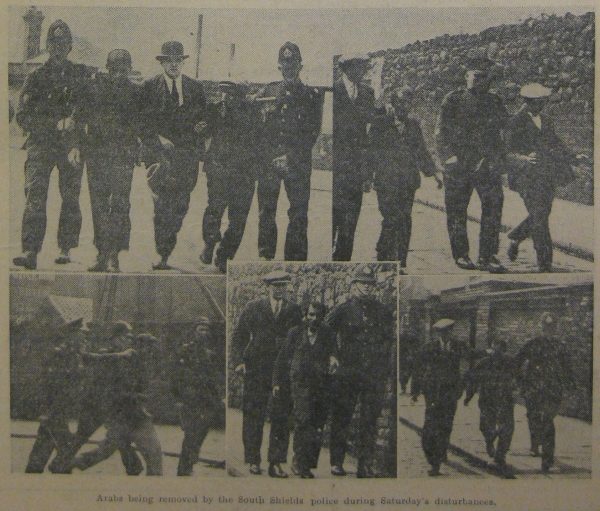

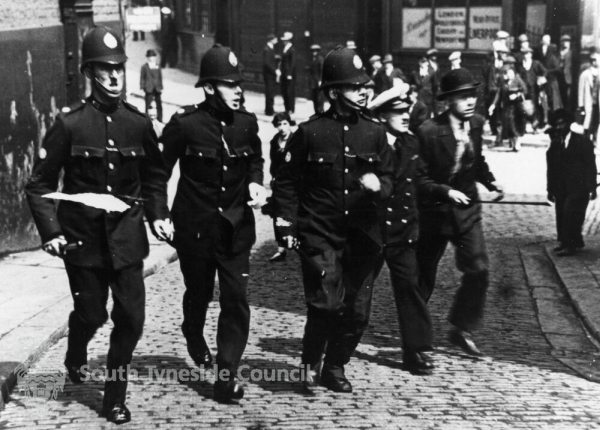
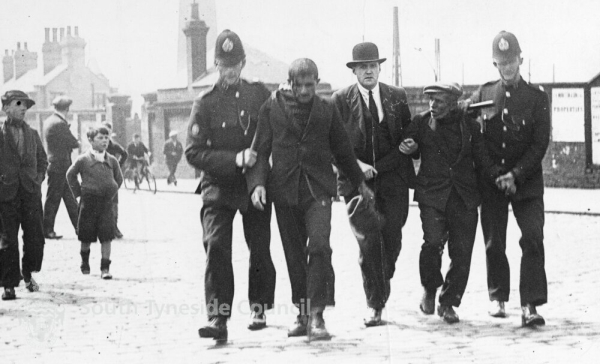
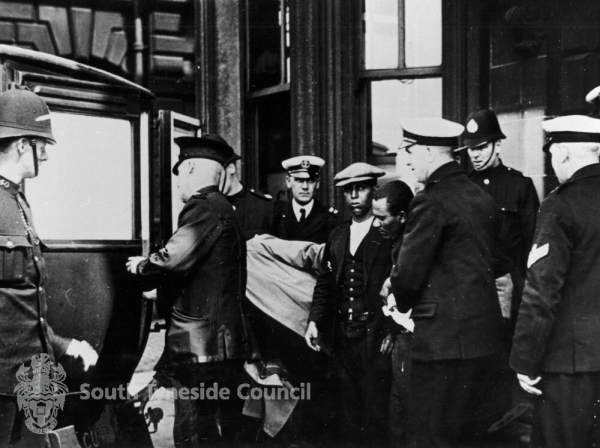
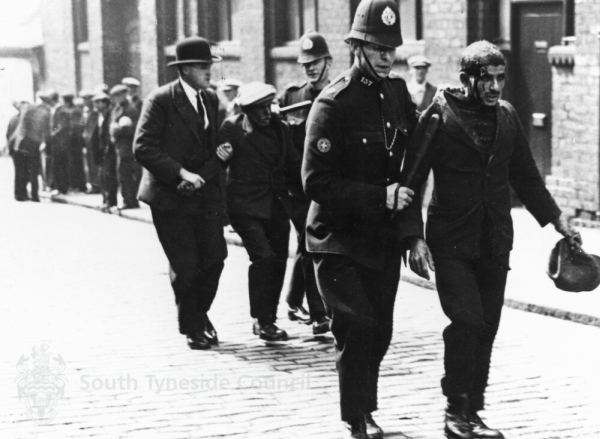
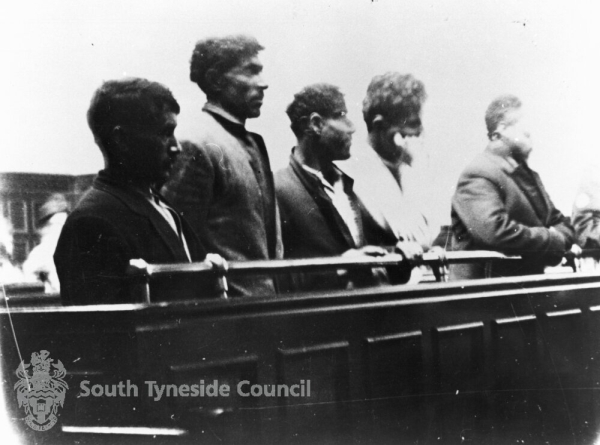

Sources:
Richard Lawless: From Ta’izz To Tyneside, pages 135-152
Laura Tabili: Global Migrants Local Culture
Photos:
South Tyneside Libraries
Shields Gazette
1934 – The Demise of Holborn
Holborn had been the main centre of the Yemeni community due to its proximity to the Mill Dam offices where seaman looked for employment.


From about 1934 the houses in East and West Holborn were being demolished as part of the Council’s slum clearance programme and by 1938 most of East and West Holborn was flattened including many of the Yemeni owned boarding houses.


In 1935 the Council proposed to segregate the Arab community in four or five storey flats around Commercial Road. There was fierce opposition to this from the Arab Community the plan was abandoned and most Arab residents ended up in Cornwallis Square or in conventional “Tyneside Flats” in Laygate.

1936- Religious Revival
Sheikh Abdullah Ali al-Hakimi arrived in South Shields in December 1936. He was the Yemeni leader of the Alawi Sufi fellowship branch of Islam.

Sheikh Abdullah started his teaching in the old Hilda Arms public house on the corner of Cuthbert Street and Smith Street. He spent several years trying to get a purpose built mosque built for the Yemeni religious community.

Richard Lawless notes:
“Setting about his work with great energy, Sheikh Abdullah appears to have encouraged something of a religious revival among the town’s Arab community. Religious life was regularized and dramatized. New rituals and practices were introduced and special attention was given to the religious instruction of the children of the community, boys and girls. In May 1938 it was reported that 150 children were attending evening classes in Qur’anic studies at the Sheikh’s zawiya in Cuthbert Street. Weekly classes for religious instruction were also provided for those wives of Arab seamen who had converted to Islam.” Richard Lawless: From Ta’izz To Tyneside, page 220.
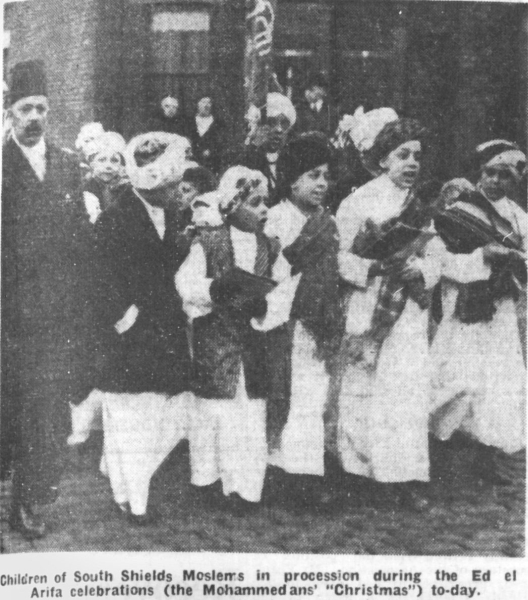

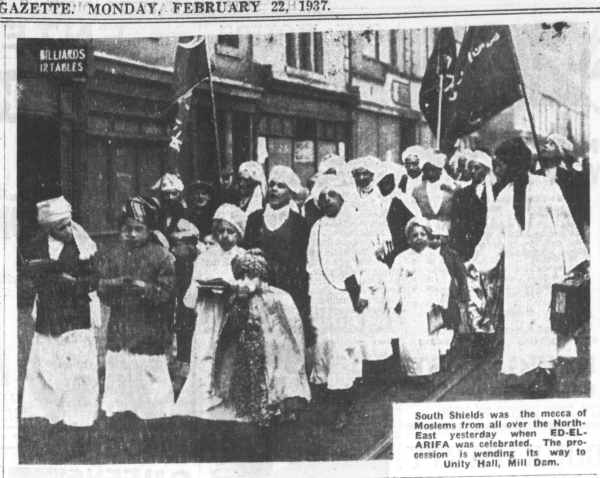
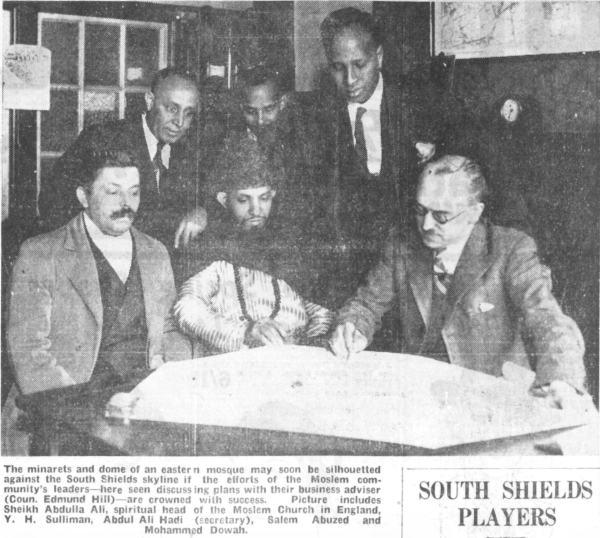

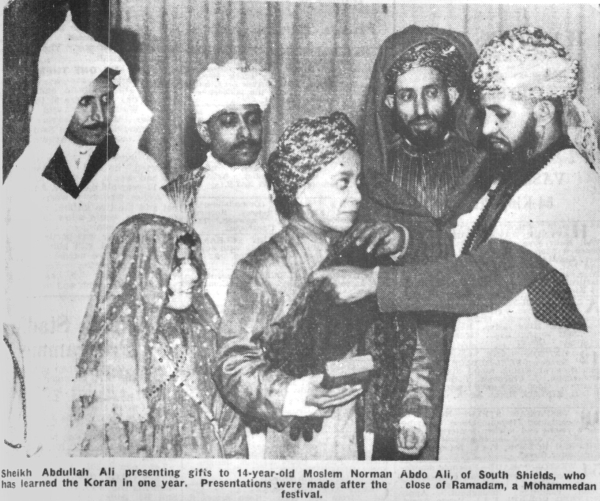

The Sheikh married Miriam Abdullah, the daughter of a late Yemeni seaman and his British wife. She tragically died very young in December 1937 and is buried in Harton Cemetery.

World War 2
During World War Two the Merchant Navy played a critical role and lost more personnel than any of the armed services with the exception of Bomber Command. Because of their location in the belly of the ship they had little chance of escape if the ship was sunk.

Many Arab seamen and their sons lost their lives during World War Two. Some of their sons joined the armed forces including Hasan Joseph Hamid who joined the RAF and was shot down over Germany in 1943 and taken prisoner.

Mohamed and Rosetta Muckble’s son Michael was a fireman in the Merchant Navy on the SS Ocean Courier and was commended for brave conduct in 1945.
In The Word is a beautiful memoriam book of Merchant Navy seamen with a huge list of seamen who sailed from South Shields during World War Two, 211 have Arabic sounding names and South Shields addresses.


After the War
After Holborn was demolished in the late 1930s many of the Yemeni residents moved nearby to the Laygate area. Here some of the Arab boarding houses, cafes and shops were re-established.

In 1960 there were still 300 Arab seamen registered with the NUS office in South Shields but by 1986 this number had dropped to between 50 and 60 and many were close to retirement. In 1961 the old mosque at Cuthbert Street was demolished to make way for Western Approach dual carriage way. The former police station (later reading rooms) on the corner of Brunswick Street, Laygate were used as a mosque.


In the late 1960s and 70s much of the old terraced housing in Laygate was demolished and many of the Yemeni families were rehoused in various other parts of the town thus making it harder to maintain old bonds but easier to integrate into the wider South Shields community.

Yemeni Wives
The majority of Yemeni seamen who came to South Shields were single men, though some married men had wives back in Yemen. Some of these single men married British women and therefore would no longer reside in a male boarding house and may even have moved out of the Holborn and later Laygate area thus making integration easier. Their children would attend local schools thus further weakening older Yemeni ties. After World War One once soldiers had demobilised and during the depression of the 1930s there was fierce competition for employment. The Shields Gazette carried many letters blaming the Yemeni seamen for this terrible situation. Some women wrote highly spirited defences of their husband’s and also translated replies for their husbands. They sometimes used pen names such as “An Arab’s Wife 23 Years” or “Arab’s Wife”.
William Dalrymple writing for The Independent in 1989 during interviews with some of them described them as:
“The women are formidable and not to be ignored – certainly if the two I met at Mr Hussein’s are anything to judge by Sylvia Hussein and her friend Emily Abdullah.”
1972 – Al-Azhar mosque
In July 1972 the Al-Azhar mosque was opened. This was the first purpose built mosque outside of London and it was built 36 years after Sheikh Abdullah’s first attempts to build a mosque in 1936.


Yusef Abdullah recalled:
“I remember as a kid I give up part of my pocket money up for the mosque. So everybody had a bit of themselves in the mosque and obviously that was a focal point for the Yemenis. It was always unofficially known as the Yemeni Mosque throughout the North East.”
1977 – Muhammad Ali’s visit
In 1977 Johnny Walker, a painter and decorator from South Tyneside who had once boxed himself invited Muhammad Ali to South Shields. Ali made the trip to South Shields from Newcastle in an open top bus. The streets were packed with people who wanted to see one of the most famous people in the world. Ali and his new wife Veronica had their recent marriage blessed at the Al Azhar Mosque. Approximately 7,000 people were outside and 300 guests witnessed the blessing inside:
“Nowhere outside of Africa have I received such a welcome” (Muhammad Ali reported by Tina Gharavi, Last of the Dictionary Men, p38).

Yusef Abdullah commented:
“I love the guy Ali and I’m very proud of him coming to South Shields. He was such a lovely man and being a Muslim and he is coming to the mosque, to our mosque, it was fantastic. When I see the photographs of him, he’s up there on the bus waving at people and looking down. My dad says he was standing at Laygate and he passed and he says, “he pointed at me”. My dad felt very, very proud. There’s a nice photograph of a friend of mine when he was a little lad, he was looking up at Ali and it is lovely. It was a proud moment for all of us.”

Boarding Houses
When any seamen came to South Shields they were required by law to stay in seamen’s boarding houses; unless they were staying with their family, this was presumably to reduce the risk of infection? Most of them were located along the riverside in Holborn, Mill Dam and the Market area. In 1900 there were 76 seamen’s boarding houses, 41 of these in the Holborn. Several of these boarding houses were owned by Yemeni families from the early 1900s. South Shields was one of the few ports in the North East to have Arab boarding houses and seamen from other local ports would come here to try to sign on a ship. Only Cardiff had more Aden born seamen than South Shields in 1921. There were 12 Arab boarding houses in South Shields 1921, this was probably the peak. After the 1930s slum clearances at Holborn some boarding houses and cafes moved to the Laygate area.
The boarding house master provided an absolutely critical role for the Yemeni seamen. He could assist in any problems with officials, send money to relatives, loan them money when they were unemployed, get them employment on ships and a multitude of other roles. Most Yemeni seamen would only have a basic level of English and little local knowledge the boarding house master was critical to them and as a consequence of this they were very important men in the Yemeni community.
The role of the boarding house went way beyond just a place to sleep. There might be a small area where prayers were said, food could be prepared in accordance with Islamic tradition, games such as dominoes would be played, newspapers read aloud and even preparing bodies ready for funerals.
After Second World War coal powered ships started to be replaced by oil powered ships though a few coal powered ships survived until the early 1970s, so the need for firemen declined. Ships became larger and more mechanised and by the 1980s fewer ships were berthing at South Shields. As a consequence of the need for fewer Yemeni seamen the number of boarding house declined. The International Seaman’s Boarding House ran by Abdullah Ali closed about 1958.

One boarding house at the bottom of Laygate roughly where the roundabout near Lidl is closed in the late 60s early 70s and by the year 2007 only 6 St Jude’s Terrace and 50-52 Brunswick Street were still operating. Now only Brunswick Street is open but is no longer used by Yemeni seamen.
1990s – 2000s – Peter Fryer
In the late 90s and early 2000s Peter Fryer photographed inside the two remaining Arab boarding houses at 6 St Jude’s Terrace, operated by Mohammed Abdul Ghani and 50-52 Brunswick Street which was owned by Mohamed Sayyadi.

Peter’s photos uniquely capture the end of an era of Yemeni seamen living or visiting boarding houses in South Shields as they had done for 100 years. The photos were used for an exhibition at the Side Gallery in Newcastle in 2007 and a book was produced with text by David Campbell called The Boarding House later a short video was made.
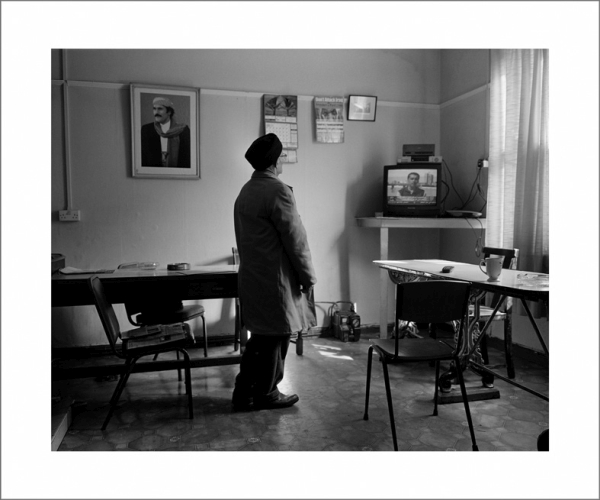
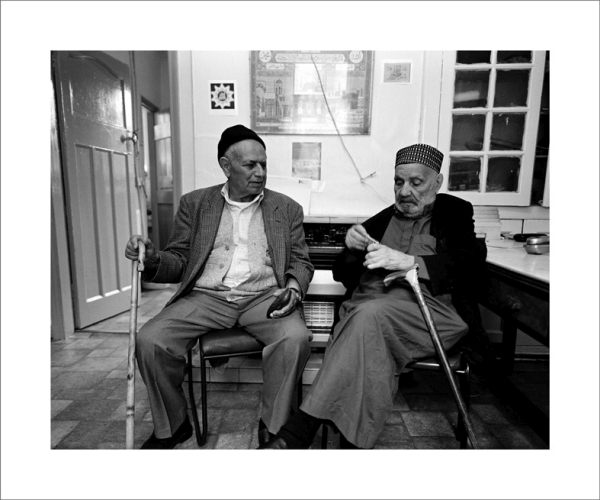
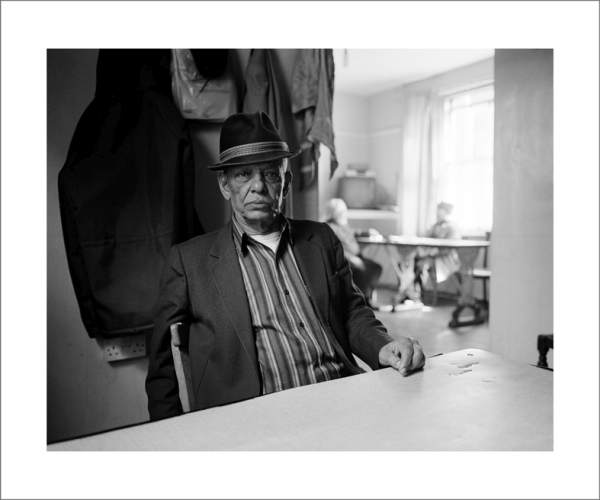
In 2023 South Shields Local History Group successfully managed to get the boarding house at 50-52 Brunswick Street onto South Tyneside’s Local List due to its historic importance.
2008 – Last Of The Dictionary Men
Last of the Dictionary Men, was based on an exhibition that opened in 2008 at the Baltic Centre for Contemporary Art in Gateshead. It was produced by Tina Gharavi, a DVD and a book was made of the exhibition which traces the history of the British-Yemeni community through the stories of the fourteen surviving seamen from this first generation, known as the “Dictionary Men”. The King of South Shields is a documentary looking at the day that Mohammad Ali came to Tyneside in 1977.

2023 – Yusef Abdullah
Yusef Abdullah ran South Tyneside Arab Muslim Community Service between 1991 and 2021. This was an organisation which supported many Yemenis who had worked as seamen and in other trades. Yusef said that in 1991 there was still between 50 to 70 Yemenis who had been in the Merchant Navy during and just after the war but most had either returned to Yemen or had since died. Yusef recalls:
Integration plays a big part in our history and our community and it’s something that we are very proud of. I mean, say in the seventies, the Sun Newspaper actually did a two-page report on South Wales Yemeni community. Deutsche Welle the German television company had been over here doing a short film, Channel Four made one, there’s been lots, even Coast to Coast has been here and done an article on the Yemeni community. And people think, well things have been so good in South Shields, especially South Shields, why is it? Well, it’s because the Yemenis are so open-minded, and as I told you early on in the interview, the Yemenis they like to know other people and get to know them and share things with them. Actually in Islam you’re told that God says we’ve made you with different tribes and nations, therefore go out and show the best of yourselves and it is an Islamic requirement.
My grandfather came here, I don’t know the exact date, before the war and he was a seaman. He became a fire officer for the National Fire Service, which he was very proud of and he had met the queen mother and he was very, very proud of that. He brought my dad over here when he was 14 and my Uncle Razaz. Anyway, he got him a job at sea, my Uncle Razaz went down to Cardiff to live and my dad worked from here going to sea.


Integration wise my dad was actually known as “The Geordie Arab”. He had a bit of a tinge of an accent, but his language was Geordie. If you didn’t know, you wouldn’t know. He ended up working in shipyards where he was known as the “Geordie Arab” and it was great. The integration at the time and people accepted Arabs. I know that there was talk about the riots and stuff like that. The riots wasn’t racial it was purely down to employment, scabbing and anti-scabbing, the Arabs wouldn’t scab. Hence why my dad wouldn’t let me scab if I’d wanted to when the pit strike was on.

But the integration was fantastic. Also as well, it’s not just the Arabs were great it’s actual Geordie people, South Shields people. But South Shields people, they are so special and they want to get to know people. The ordinary man wants to get to know people. But South Shields is so special, and as I say the Sun newspapers and other organisations wanted to know why there was good race relations in South Shields. And that’s the reason because there is bridges being built from both sides, not just from the Arab side or the English side’s but from both sides and people have met in the middle. But I have been to other parts of the country where there’s Yemeni communities and they’re not as good as South Shields and it’s because of the Geordie man or woman!
Sources:
Yusef Abdullah interviewed 5th October 2023
Barry Carr: “Black Geordies” from Geordies edited by Robert Colls
British Newspaper Archives
Census data
Peter Fryer: The Boarding House
Tina Gharavi: Last of the Dictionary Men
Richard Lawless: From Ta’izz To Tyneside
Laura Tabili: Global Migrants Local Culture
Photos:
British Newspaper Archives
Peter Fryer
Mike Mulhern
South Tyneside Libraries
